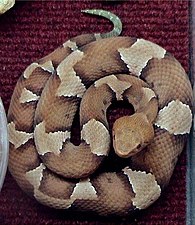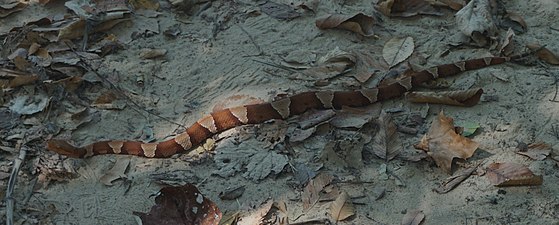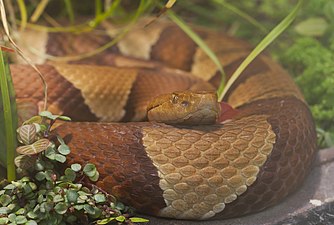Agkistrodon laticinctus
| Agkistrodon laticinctus | |
|---|---|

| |
| Scientific classification | |
| Domain: | Eukaryota |
| Kingdom: | Animalia |
| Phylum: | Chordata |
| Class: | Reptilia |
| Order: | Squamata |
| Suborder: | Serpentes |
| Family: | Viperidae |
| Genus: | Agkistrodon |
| Species: | A. laticinctus
|
| Binomial name | |
| Agkistrodon laticinctus | |
| Synonyms | |
Agkistrodon laticinctus, commonly known as the broad-banded copperhead, is a
Description

This form is typically a light tan in color, with darker brown, wide crossbands - which gives it its common name. The actual color varies, by locality, from a red-brown, to a gray-brown. It overlaps with the southern copperhead,
Common names
Common names for this species include: broad-banded copperhead, copperhead moccasin, copperhead snake, dry-land moccasin, highland moccasin, moccasin, rattlesnake pilot, red eye, Texas copperhead[4] and thunder snake.[4]
Geographic range
Agkistrodon laticinctus is known to populate the region between 97 degrees and 99 degrees west longitude, from Central Texas north to the southern border of Kansas and Oklahoma.[4]
Behavior
Secretive and
Venom
Like most
Gallery
-
Broad-banded copperhead
-
Broad-banded copperhead (Agkistrodon laticinctus)
-
Closeup of a Broad-banded copperhead (Agkistrodon laticinctus)
-
Belly or ventral view of a Broad-banded copperhead (Agkistrodon laticinctus)
-
A juvenile Agkistrodon laticinctus with yellow tail
-
Broad-banded copperhead (Agkistrodon laticinctus)
-
A broad-banded copperhead at Dinosaur Valley State Park, Somervell Co., Texas (10 October 2020)
-
Agkistrodon laticinctus photographed at the Hellabrunn Zoo, Múnich, Germany
References
- ISBN 1-893777-01-4(volume).
- ^ "Agkistrodon laticinctus". Integrated Taxonomic Information System. Retrieved 15 May 2007.
- ^ ISBN 0-8014-0463-0.
- ^ Salmon, G. T., H. W. Greene, and T. Dimler. "Biology of the Pitvipers 2." Biology of the Pitvipers 2. Department of Ecology and Evolutionary Biology, Cornell University, Ithaca, NY, USA, 4–7 June 2014. Web. 19 July 2014.
External links
- Agkistrodon contortrix at the Reptarium.cz Reptile Database. Accessed 7 December 2007.
- Agkistrodon contortrix at University of Texas. Accessed 7 December 2007.
- Agkistrodon at Department of Biology, Southeastern Louisiana University, Hammond, LA70402. Accessed 15 June 2021.








